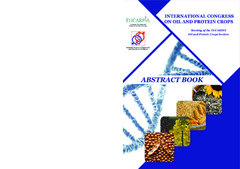Приказ основних података о документу
Genotypic variation of oil and protein content in seeds of camelina (Camelina sativa (L.) Crtz.)
| dc.creator | Marjanović-Jeromela, Ana | |
| dc.creator | Grahovac, Nada | |
| dc.creator | Glogovac, Svetlana | |
| dc.creator | Cvejić, Sandra | |
| dc.creator | Miladinović, Dragana | |
| dc.creator | Kondić-Špika, Ankica | |
| dc.creator | Vollmann, Johann | |
| dc.date.accessioned | 2021-11-08T10:03:10Z | |
| dc.date.available | 2021-11-08T10:03:10Z | |
| dc.date.issued | 2018 | |
| dc.identifier.isbn | 978-9975-3178-5-6 | |
| dc.identifier.uri | http://fiver.ifvcns.rs/handle/123456789/2390 | |
| dc.description.abstract | Camelina sativa (L.) is an ancient oilseed crop that belongs to the Brassicaceae family. Camelina’s adaptation to enormous areas of the world has resurfaced interestfor this crop, due to its unique oil composition of seed and attributes useful for the production of food. The oil of seed camelina has excellent nutritive value due to the abundance of essential fatty acids, while the meal is a high quality protein-rich component for animal feed. Additionally, camelina oil has a lot of potential benefits for human health and can be used as salad or cooking oil. Also, some reports point out that intake of camelina oil reduces cholesterol in blood serum. Evaluation of health-beneficial chemicals in camelina seed, such as oil and proteins, is important for the breeding. This study was carried out to estimate the variability of oil and protein content in a collection of 20 camelina genotypes from different selections. A field experiment was conducted on the location of Rimski Šančevi (Vojvodina Province, Serbia or 45°20′N, 19°51′E, 87 m altitude). The protein and oil content of the camelina samples were analyzed by near-infrared reflectance spectroscopy (NIRS). Cluster analysis was used to sort the genotypes according to the degree of similarity. Significant differences were found for the investigated genotypes. Oil content ranged from 29.90% to 36.73%, with the mean of 33.22% and coefficient of variation (CV) 5.75%. Protein content ranged from 29.02% to 35.59% with average value of 32.84% and the CV of 5.91%. The analysis of variance showed statistically significant differences between the genotypes in the investigated traits (p < 0.001). | sr |
| dc.language.iso | en | sr |
| dc.publisher | Wageningen : European Association for Research on Plant Breeding | sr |
| dc.publisher | Chisinau : Scientific Association of Geneticists and Breeders from the Republic of Moldova | sr |
| dc.relation | info:eu-repo/grantAgreement/MESTD/Technological Development (TD or TR)/31025/RS// | sr |
| dc.relation | Bilateral project Serbia - Austria, 451-03-01039/2015-09/42 | sr |
| dc.rights | openAccess | sr |
| dc.rights.uri | https://creativecommons.org/licenses/by/4.0/ | |
| dc.source | Book of Abstracts, International congress on oil and protein crops : Meeting of the EUCARPIA Oil and Protein Crops Section, 20-24 May 2018, Chisinau, Republic of Moldova | sr |
| dc.subject | genotypic variation | sr |
| dc.subject | oilseed | sr |
| dc.subject | Camelina sativa (L.) | sr |
| dc.subject | essential fatty acids | sr |
| dc.subject | Cluster analysis | sr |
| dc.subject | oil content | sr |
| dc.subject | protein content | sr |
| dc.title | Genotypic variation of oil and protein content in seeds of camelina (Camelina sativa (L.) Crtz.) | sr |
| dc.type | conferenceObject | sr |
| dc.rights.license | BY | sr |
| dc.citation.epage | 40 | |
| dc.citation.spage | 40 | |
| dc.identifier.fulltext | http://fiver.ifvcns.rs/bitstream/id/6507/bitstream_6507.pdf | |
| dc.identifier.rcub | https://hdl.handle.net/21.15107/rcub_fiver_2390 | |
| dc.type.version | publishedVersion | sr |


